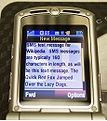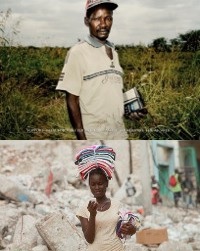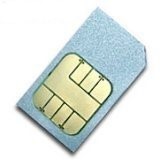Our dream at engageSPARK – the first product under the Opportunity Labs umbrella – is to make it very easy to use the mobile phone for social good. We have identified some neat ways to achieve this and we can’t wait to share engageSPARK with everyone once it’s ready. Our solution is not going to exist in a vacuum and so in this post, we will look at the core mobile technologies that have enabled mobile for development (“M4D”) and the trade-offs between these technologies. For the reader new to M4D this will provide a very brief overview of how mobile phones are being used for socio-economic development (a more in-depth introduction to M4D is available here). For the seasoned/practicing M4D’er you may find our discussion on the technologies and their trade-offs useful – we definitely would also love to hear about your experiences with other technologies.
Mobile Phone Use is on the Rise! What Next?
The fact that mobile phone ownership is rapidly increasing around the world is no longer shocking. Exciting at first because, unlike most technology trends, this unprecedented rate of proliferation is being driven by demand from the developing parts of the world, this fact is now raising fewer eyebrows. At the moment, the immediate question on most observers’ minds is “how do we take advantage of this thing?”
In the West (using the socio-economic sense of the term), companies like Apple with its iPhone series and mobile apps like Instagram are defining lucrative means of riding this wave by enabling their customers to express their individuality in creative new ways through their phones. Similarly, businesses and entrepreneurs in the developing world are crafting equally wallet-fattening approaches by addressing service and information gaps with innovative mobile products like M-PESA, iCow, and mPedigree, to name a few.
Of course, all of this excitement has not escaped the attention of the public sector and non-governmental organizations that have the socio-economic well-being of people at heart. The combination of an in-need person – be it due to a lack of health, financial or civil liberties –
and a mobile phone is the most electrifying thing (maybe after vaccines, bed nets, dewormers, clean cookstoves, and air-conditioned SUVs) to happen to the do-gooder community since
wireless radio! Yes, OLPC was exciting, but we were all quite tentative about getting on board, weren’t we? On the contrary, with the mobile phone’s ability to support bi-directional interactions – sending and requesting information – while transcending barriers such as cost of ownership, distance, literacy and gender, there has been little hesitation in adopting mobile phones for development purposes.
And how the do-gooders have seized on this opportunity! True to their own methods, an amazing number of pilots – accompanied invariably by an accouterment of theoretical frameworks and impact studies – are being launched daily. Also, supporting these projects is an assortment of innovative technologies with enough acronyms to make the U.S. Army jealous.
In this blog post, we will explore the nature of the core technologies underlying these M4D innovations, including the problems they address (broadly).
M4D: What Are Mobile Phones Being Used For?
Before we dive into the technology, it is useful to get a sense of what and why mobile phones are being used in development projects. Broadly speaking, mobile phone use falls into two categories: information dissemination and data collection.
Information Dissemination
Similar to the radio, a powerful feature of the mobile phone is the ability to reach anyone, anywhere (provided they have a phone and there is connectivity – more on that later), at any time with personalized information. For development practitioners, this is proving to be incredibly cost-effective, for example, in augmenting time- and human resource-intensive training workshops with on-demand mobile phone-based education programs. Even more useful, and unlike the radio, is the ability to target individuals with messages – this has sprouted a host of mobile phone-based interventions ranging from drug adherence campaigns for HIV-positive patients to services providing personalized, maternal informational messages to expecting mothers. The mobile phone is quickly becoming the de-facto mode for interacting with development beneficiaries and field workers due to its capacity to reach anyone, where they are, and in a medium they understand.
Data Collection
Mobile phones enable the ability for bi-directional interactions over multiple channels such as audio and SMS (and an alphabet soup of other technologies we will discuss later on). Bi-directional communication is extremely important to development practitioners for receiving timely feedback from their clients. For example, the mobile component of Ushahidi allows for real-time reporting of election malpractices. From surveys on agricultural practices to routine collection of health data, the mobile phone is proving to be an important tool for shaping development interventions for the betterment of people in need.
In each of these use cases, the mobile phone improves the flow of information: it extends the reach of information in terms of overcoming time and geographic distances and providing access to hitherto difficult-to-access groups (e.g. sex workers), while allowing for the reverse flow of information from clients. This improved information flow can lead to remarkable time and financial savings: this is evident in Rob Jensen’s 2007 work on fishermen in Kerala where mobile phones improved the availability of market pricing information leading to both more efficient markets and better livelihoods for the fishermen. Such benefits from improved information flow are why development agencies are investing in M4D projects.
M4D: A Basic Primer on the Technology Involved
So that’s the why and what of M4D; the how follows. The radio has transmitters, transmission frequencies, and broadcasters with evocative voices and cool names (looking at you Ira Glass). Without them, a radio set is pretty mute. Similarly, a mobile phone depends on an array of other technologies to fully function. In this section, we will provide in very non-technical terms a description of each of these technologies.[1] This is important to know because these technologies define both the opportunities and limitations of mobile phones.
Base Stations / Cell Towers
These are the tall masts with antennas and satellite dishes you see dotted around town. They transmit low-power radio signals to mobile phones to let them know they can make and receive calls. When a call is made from the mobile phone, a radio signal is sent to the nearest base station, which then transmits it to the main telephone network. The telephone network then forwards the calls to the closest base station to the receiver, which forwards the call onto the receiver’s mobile phone. Base stations are important for M4D because the fewer there are in large areas, the weaker the network coverage – making it difficult to contact people. This is typically the case in rural areas and so it’s important to understand the mobile phone coverage in a particular area before implementing an M4D project there.
Subscriber Identity Module (SIM)
Typically referred to as a SIM card, this is a tiny circuit board that stores security information that is used to uniquely identify a mobile device and also authenticate it to a particular network – think of it as a passport that holds the necessary information required to give you access to a mobile network. Without it, you cannot make a call or send a text message from the phone over a mobile network – there are virtual SIMs that allow you to make calls without a SIM card, but that is beyond the scope of this post.
Apart from identity/authentication information, the SIM holds other data (more on that here) and also allows you to store information on up to 250 contacts on it. It is possible to develop tiny applications that run on a SIM. Known as SIM apps, these applications tend to be menu-based and can also take input from the user. Given that these apps run on the SIM, they provide a high level of security (i.e. they can access the security information on the phone and use it for verification purposes) and can work on any phone. Despite these great features, SIM apps are not as popular in the M4D space because: (1) they are difficult to update once a SIM has been given to the client (there is a way to get around this, but it’s not very easy); (2) they only support basic pictures and no other multimedia; and (3) developing and maintaining a SIM app requires quite a bit of technical expertise.
Short Message Service (SMS)
Apart from voice calls, mobile phones can send text messages to each other. These messages can only be 160 characters in length. However, new phones do allow you to send more characters by doing the work for you – they break up the message into 160-character long pieces and then re-assemble the pieces on the receivers’ phone. When an SMS is sent it first goes to the main network center and then it is forwarded to the recipient. This means that if the network is down, the message can always be resent at a later time by the network center. Over a typical network, about 6-10 SMSs can be sent every minute by phone.

Image by Scaredpoet
Text messages are a very popular way of sending and receiving information in M4D projects; however, the limited text length requires extra attention when creating content for the SMS medium and it also requires literate recipients. Also, for data collection, the text of the SMS needs to be clearly defined (e.g. AGE 23:DOB 12/03/2012:) so that the recipient of the data knows how to process it – this is called a Structured SMS. Using structured SMS for data collection typically requires the data collector to be thoroughly trained on how to key in the data. More on SMS technology is available on Wikipedia.
Unstructured Supplementary Service Data (USSD)
This is another way of sending messages to and from mobile phones. A USSD service is accessed by calling a number that typically starts with an * or # and ends with a # (e.g. *123*2344#) and the message can be 182 characters long. However, unlike SMS where messages go through the network center, USSD messages go directly to and from the phone, thus making it more responsive than SMS (think of SMS as a letter and USSD as directly handing a note to someone). However, the connection time is also limited, meaning the recipient only has a small amount of time to respond to a question using USSD. Also, because USSD messages do not conform to any set standards, a USSD service defined for one telecom network, may not work with another.
In practice, USSD is mainly used to provide a more interactive registration process for services and also in mobile-money services for sending and receiving stored credit. Although receivers have to be literate to use USSD services, the increasing use of USSD for recharging phone credit, coupled with the better numeracy skills of illiterate subscribers means USSD is a viable means, especially for registration into programs and interacting with illiterate populations. More on USSD technology is available on Wikipedia.
General Packet Radio Service (GPRS)
This is a standard protocol that defines how data is transmitted to and from a mobile phone. GPRS also allows phones to send SMS (with GPRS 30 messages can be sent by phone per minute compared to the typical 6-10 for SMS), use Multimedia services (MMS), and access the Internet. The speed of the connection is dependent on the type of network. Third-generation (3G) and fourth-generation (4G or LTE) networks provide speeds fast enough to stream videos to a mobile phone. However, most rural and peri-urban areas in developing countries tend to only have access to Second Generation (2.5G) networks. GPRS/data connections are very useful for mobile data collection systems. Per unit of data (measured in bytes), it is cheaper to use GPRS than SMS. Also, depending on the phones your clients have (see more on that below), you can deploy applications that allow for data collection even in the absence of network connectivity.
Mobile Handsets
Finally, there is the mobile phone. Currently, there are 3 main types of handsets, defined by the functionality they provide: dumb phones, feature phones and smartphones. Dumb phones can only make and receive voice calls, USSD, and SMS messages. Featured phones have the additional ability to run 3rd party applications – most are written in the Java programming language – and they also support GPRS for the transmission of data. These are the most common phones you will find in developing countries – a common brand is the Nokia Asha phone series.
Smartphones typically have more advanced computing features than feature phones. Apart from basic calling and messaging, smartphones typically have cameras that can be used to read bar or QR codes, enough memory to hold and playback audio files, and the ability to access the Internet through both Wi-Fi and mobile broadband connections (3G and 4G/LTE). Examples of smartphones are the iPhone and Android phones. Android is quite popular in developing countries because of the affordable price and also the ability to cheaply develop various applications for the open source Android platform.
Together, these key technologies provide the basic building blocks on which most M4D tools are built. Below is a table listing communication channels, some pros and cons of each channel, and some popular tools in use by M4D projects.
M4D: Pros & Cons of Core Technologies; Example Tools
| Message Medium | Supported Phone Type | Pros | Cons | Example Tools |
| SIM Application | All |
|
|
|
| SMS | All |
|
|
|
| USSD | All |
|
|
|
| Voice | All |
|
|
|
| Data | Feature and Smartphone |
|
|
|
Conclusion
This is the technical underbelly of the M4D world in which we plan to introduce engageSPARK. We’re building the first fully self-service SaaS solution for both SMS and Voice targeted at developing countries, where a non-technical person can launch (from start to finish) a simple or complex campaign or survey within minutes – in just about any country in the world.
Our goal is to make it so that development organizations don’t have to worry about any of the technologies mentioned above to implement their M4D projects. After all, technologies are just a tool. Instead, we want to help them focus more on the content, the theories of change – especially their processes for implementation (especially training), measurement, and evaluation. We think that creating a complex decision tree engagement to help people look up medical information should not require hiring a technical team and take months to launch.
If you’re interested in our project, consider helping us design it better by sharing your experience implementing an M4D project. We are particularly interested in:
- Anyone with experience creating an SMS or Voice based campaign (For-profit businesses and NGOs)
- Anyone interested in creating SMS or Voice campaigns to reach the poor and illiterate or to reach consumers (for-profit business sector)
Email sunnyy at engagespark dot com with the following information:
- Name and Title
- Organization & Location
- Brief description of your SMS/Voice campaign creation experience or needs
That’s it! Don’t forget to share any insights or thoughts you have about this topic with the community in the comments below.
[1] For those technically minded, the descriptions focus on GSM-related technologies although some apply to other standards like CDMA. We chose GSM because it’s the most widely used in developing regions, and about 80% of the world’s networks are GSM.




